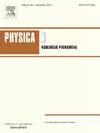Entanglement properties of photon–magnon crystal from nonlinear perspective
IF 2.9
3区 数学
Q1 MATHEMATICS, APPLIED
引用次数: 0
Abstract
Quantifying the entanglement between two continuous bosonic modes, such as magnons and photons, is not trivial. The state-of-the-art for today is the logarithmic negativity, calculated through the quantum Langevin equations subjected to thermal noise. However, due to its complexity, this method requires further approximation. Namely, after the linearization procedure, quantum operators are replaced by their semiclassical expectation values calculated near the steady state. However, the phase space of a generic nonlinear system contains topologically different regions, and the steady state may correspond to the different types of fixed points, such as Saddle Points, Stable or unstable Spirals, and Nodes. Through the conventional linearization procedure, one obtains equations for the photon and magnon number operators, but the character of the fixed point is unexplored. In the present work, we propose a new procedure. Namely, we derived the complete set of nonlinear equations, which includes equations for the magnon and photon number operators and phases. We show that not only number operators but also phases are important for exploring the character of the fixed point, and the character of the fixed point influences the magnon–photon entanglement. We showed that methods of the qualitative theory of nonlinear differential equations are also relevant for photon–magnon entanglement problems. Our main finding is that entanglement is not defined in the Saddle Point region. On the other hand, the maximum of the entanglement corresponds to the region near the border between the Stable node and Stable spiral regions. Our approach is quite general. However, we did calculations for a particular system: photon–magnon crystal based on the yttrium iron garnet (YIG) film with the periodic air holes drilled in the film. Our interest focuses on magnons with a particular wavelength and frequency corresponding to the magnon condensate. Those magnons couple strongly with the photons of similar frequency. We discuss in detail the interaction between magnons and photons originating from the magneto-electric coupling and the effective Dzyaloshinskii–Moriya interaction. We show that this interaction is responsible for the robust photon–magnon entanglement in the system.
非线性视角下光子-磁振子晶体的纠缠特性
量化两个连续玻色子模式(如磁振子和光子)之间的纠缠不是一件容易的事。今天最先进的是对数负性,通过受热噪声影响的量子朗之万方程来计算。然而,由于其复杂性,该方法需要进一步逼近。即,在线性化过程之后,量子算子被其在稳态附近计算的半经典期望值所取代。然而,一般非线性系统的相空间包含不同的拓扑区域,稳态可能对应于不同类型的不动点,如鞍点、稳定或不稳定螺旋和节点。通过传统的线性化方法,得到了光子数算子和磁子数算子的方程,但对不动点的性质没有研究。在目前的工作中,我们提出了一个新的程序。也就是说,我们导出了完整的非线性方程组,其中包括磁子和光子数算子和相位的方程。结果表明,不动点的性质不仅与数算符有关,还与相位有关,而不动点的性质影响着磁子-光子纠缠。我们证明了非线性微分方程的定性理论方法也适用于光子-磁振子纠缠问题。我们的主要发现是纠缠在鞍点区域没有定义。另一方面,纠缠的最大值对应于稳定节点和稳定螺旋区域边界附近的区域。我们的方法很一般。然而,我们对一个特殊的系统进行了计算:基于钇铁石榴石(YIG)薄膜的光子-磁振子晶体,薄膜上钻有周期性的空气孔。我们的兴趣集中在具有与磁振子凝聚相对应的特定波长和频率的磁振子上。这些磁振子与相似频率的光子强烈耦合。我们详细讨论了磁电耦合产生的磁振子和光子之间的相互作用以及有效的Dzyaloshinskii-Moriya相互作用。我们证明了这种相互作用是系统中鲁棒光子-磁振子纠缠的原因。
本文章由计算机程序翻译,如有差异,请以英文原文为准。
求助全文
约1分钟内获得全文
求助全文
来源期刊

Physica D: Nonlinear Phenomena
物理-物理:数学物理
CiteScore
7.30
自引率
7.50%
发文量
213
审稿时长
65 days
期刊介绍:
Physica D (Nonlinear Phenomena) publishes research and review articles reporting on experimental and theoretical works, techniques and ideas that advance the understanding of nonlinear phenomena. Topics encompass wave motion in physical, chemical and biological systems; physical or biological phenomena governed by nonlinear field equations, including hydrodynamics and turbulence; pattern formation and cooperative phenomena; instability, bifurcations, chaos, and space-time disorder; integrable/Hamiltonian systems; asymptotic analysis and, more generally, mathematical methods for nonlinear systems.
 求助内容:
求助内容: 应助结果提醒方式:
应助结果提醒方式:


